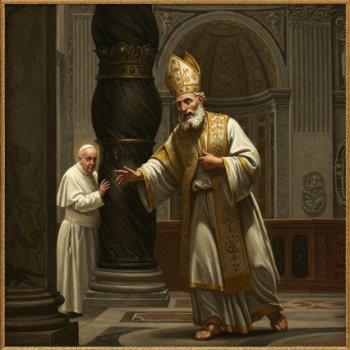In his big-screen debut, Tintin won’t be picketing any abortion clinics, or testifying before Congress on health care and freedom of conscience. More’s the pity, too, because at a certain early point in his life, he might have jumped at the chance to do either. Like so many of us, the globetrotting boy reporter is a lapsed Catholic.
In the comic strips, Tintin never discusses his family, but the character’s true father was Belgian cartoonist Georges Rémi, who worked under the name Hergé. (Among Belgian cartoonists, single-word pseudonyms seem to have been quite fashionable; Pierre Culliford, the mastermind behind the Smurfs, adopted the handle “Peyo.”) Hergé’s initial employer was a priest named Norbert Wallez, who served as editor of the Catholic magazine Twentieth Century. A bit of a crank, Fr. Wallez kept an autographed portrait of Mussolini on his wall and campaigned for Belgium’s amalgamation with the Rhineland. Under his direction, Twentieth Century became, in the words of the bio that appears on Tintin’s website, a forum in which to “sing the praises of order, hierarchy and national grandeur.”
But it’s often a broken line that separates crank from visionary. The Adventures of Hergé, a graphic novel depicting the cartoonist’s life in Hergé-style cartoons, shows the ideologue abbé advising the hero that he’ll never be a real reporter. The future Hergé’s “vocation,” as Wallez puts it, is in drawing cartoons for kids. The conversation would have taken place in 1929, putting Hergé’s age at 22. Driving an ambitious young man toward what might have appeared an un-serious occupation must have taken a delicate combination of force and tact — in short, a true pastoral presence.
In Tintin’s adventures, Wallez saw a vehicle for plugging his own views. The first two books, Tintin in the Land of the Soviets and Tintin in the Congo, constitute polemics against communism and for the European colonization of Africa. (Hergé, naturally enough, backed off the second of these, reworking some of the grosser depictions of the natives in subsequent editions.) But even more useful to Wallez was Tintin himself. Adventurous, modest and cheerful, Tintin presented young Catholics with an ideal that was both accessible and attractive. In his youth, as in his habit of meandering into political intrigues (and, if cynics are to be hearkened to, in his ambiguous sexuality), he resembles his chief rival for the hearts of pious Francophones, Joan of Arc. Unlike the Maid of Orléans, however, Tintin makes it out of his jams alive and unaided by mystical visions.
In the early 20th century, this new concern for the evangelization of youth was a Churchwide phenomenon. The scouting movement, grounded in the “muscular” Protestant Christianity of Thomas Hughes, found an enthusiastic reception in Catholic countries. Hergé himself had been a Boy Scout, and made a point of infusing Tintin’s personality with Boy Scout ideals — if Tintin ever failed to be trustworthy, loyal, helpful, friendly, courteous, kind, obedient, cheerful, thrifty, brave, clean, or reverent, that moment has been lost to critics. For the most part, Hergé kept his hero’s reverence implicit; we never see him rushing to church on St. Francis’ feast day to get Snowy blessed. Wallez, who seems to have understood the power of soft-touch evangelizing quite well for a near-fascist, never insisted he do otherwise.
Gradually, Hergé slipped free of Wallez’s influence. In 1933, apparently owing more to his abrasive personality than his views, Wallez lost the editorship of Twentieth Century. Tintin became less of an apologist for empire and more of a crusader for the universal brotherhood of man. In The Blue Lotus, Hergé vilifies the Japanese for engineering the Mukden Incident and occupying Manchuria. Though he spent the occupation years drawing for Le Soir, a Nazi-managed paper, he never made his character salute the swastika. In Adventures of Hergé, someone remarks that reading of Tintin’s adventures cheered captured Belgian resistance fighters as they awaited their turn with the Boche firing squad.
That’s a tribute to bring tears to a glass eye, as Captain Haddock might say. But so, in its way, was Nazi collaborator Léon Degrelle’s claim to have served as Tintin’s real-life model. Degrelle, who founded Belgium’s ultra-right Rexist party, commanded a batallion for the Waffen SS. Once he beat up a priest for refusing to serve him Communion when in uniform. After Hergé’s death, Degrelle published Tintin mon copain, or “My Buddy Tintin,” in which he makes his case for having inspired the cartoonist. At the time of publication, Degrelle was living in Spain, an exile condemned to death in absentia by a Belgian court for treason.
There’s something alarming about any grown man who overidentifies with a comic-book character. (Psychologists, recalling Hitler’s absorbing fascination with Karl May’s Wild West novels and Disney’s Snow White, might posit a connection between totalitarianism and infantilism.) But the fact remains, Degrelle had led a genuinely adventurous life. As a reporter in Mexico, he’d covered the Cristero War; at the end of World War Two, he escaped by stealing a German bomber and crash-landing the thing on a Spanish beach. In between, he’d managed to win the Knight’s Cross, Nazi Germany’s most prestigious award for battlefield valor. If Hergé had felt the need to give his hero a psychotic twin, he could have found no better raw material than Degrelle. In fact, though Degrelle almost certainly didn’t inspire Tintin, it’s pretty obvious that Tintin inspired him.
The point here is not to charge Degrelle’s crimes to Tintin’s account. That would be as unfair as charging the Reagan and John Lennon shootings to Holden Caulfield’s. No, I mean to cite Tintin as an example of the heights that Catholic pop culture once attained. Too many Catholics waste their time wondering when the next Flannery O’Connor might come along; they should be clasping their hands in prayer for the return of Hergé. He created a character that made good Catholic behavior appealing, but with the churchy stuff far enough in the background that a Nazi would want to claim him. If that’s not magic, what is?















